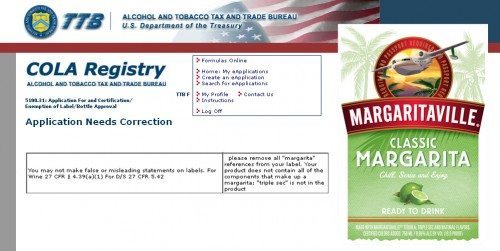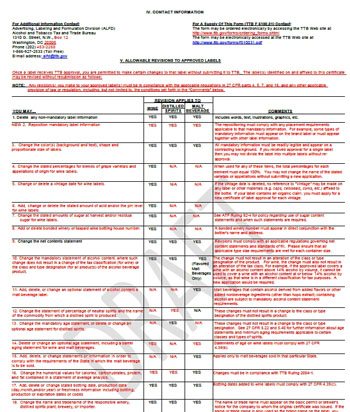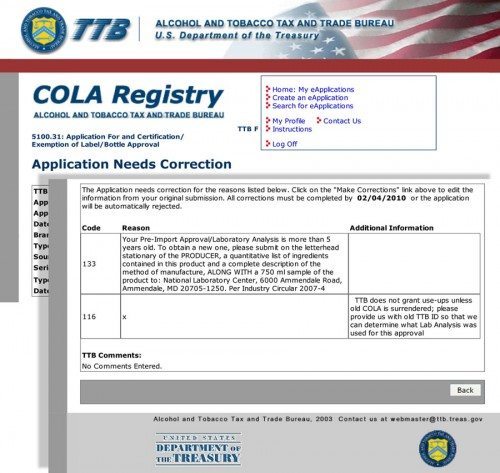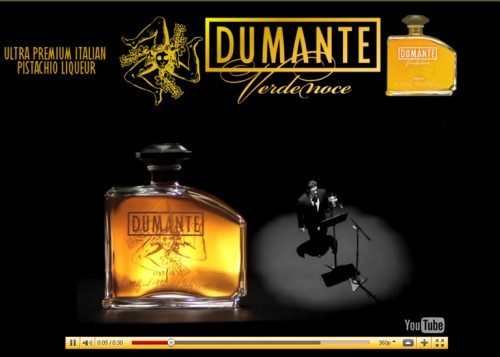The highly secretive and powerful Triple Sec lobby has struck again — this time to require at least one drop of triple sec in certain alcohol beverages. Google it as much as you wish, and you will find little about this uber-secret institution, rumored to have strong ties leading all the way back to France. That’s because it’s secret. Some even say that Sen. John Kerry, with his thinly disguised sympathies for many things French, is Triple Sec’s man in Washington.
On a more serious note, for many years, TTB has required at least some triple sec in products that purport to be margaritas. The policy is here, at page 13 (scroll down to Margarita). The policy is in TTB’s “Beverage Alcohol Manual” for spirits. The BAM can be a handy resource to explain and supplement the regulations. Sometimes, as here, it goes considerably beyond what the law or regulations say. In this particular case, it seeks to mandate that every margarita must have: “Tequila, triple sec and lime or lemon juice or oil or natural lime or lemon flavor.” Here is a recent example of TTB seeking to enforce the rule.
Does such a rule make any sense in this day and age of scarce resources? What is the worst that would happen if such a rule went away? Some may say the rule does not go far enough — and should similarly apply to malt beverages, wines, cocktails prepared at retail premises and even homes. If you have any doubt about the hushed-up threat presented by this rule (explaining how to make various cocktails), do not forget that the same rule also requires just a little bit of cream — or crème as some call it — in a Grasshopper or Pink Squirrel.
Dogs + Fishes, Beer + Wine
Shanken News Daily recently alerted us to Dogfish Noble Rot. It is:
a wine/beer hybrid that combines traditional barley, hops, water and yeast with winegrapes. Named for the grape fungus botrytis, which is associated with Sauternes and Tokaji dessert wines, Noble Rot uses Viognier and Pinot Gris grapes sourced from Washington’s Alexandria Nicole Cellars. The 9%-abv offering will be available in about 27 states this week, priced at $13 a 750-ml.
The statement of composition on this product looks a bit redundant, with two references to grape must — but upon closer review it nicely underscores the distinction about adding the grape must before and after fermentation. I wonder if the must added before fermentation could or should be considered wine. Dogfish explains:
The first addition is unfermented juice, known as must, from viognier grapes that have been infected with a benevolent fungus called botrytis. This noble rot reduces the water content in the grapes while magnifying their sweetness and complexity. The second is pinot gris must intensified by a process called dropping fruit, where large clusters of grapes are clipped to amplify the quality of those left behind. “This is the absolute closest to equal meshing of the wine world and the beer world thats ever been done commercially,” says Dogfish’s Sam Calagione.
The Washington Post apparently saw this beer a long time ago and added many crucial details:
Thousands of years ago, notes Sam Calagione, our distant ancestors didn’t draw a semantic line in the sand between beer and wine. Whatever fermentables they had, whether grain or fruit, went into a common pot to produce their unique tipples.
What is noteworthy is that the grapes and the grain each contribute about half of the fermentable sugars.
Given that beer and wine are taxed and regulated differently, did Calagione get any flack from alcohol regulatory authorities? “The only challenge was that the TTB [Tax and Trade Bureau] wanted a better description of at what point we added the grapes,” noted Calagione. For the record, the botrytis-infected must (the unfermented grape juice) is added after the boil, and the pinot gris juice post-fermentation, primarily for extra aroma.
Calagione estimated that he made about 4,400 cases of Noble Rot and expected it to linger on shelves until May. He anticipated prices of $12-13 for a 750-mililiter bottle. That will scarcely recoup his costs, he added. “I paid $62,000 alone to transport a tanker truck of temperature-controlled grape must from coast to coast,” he noted.
Aside from the joy of experimentation, Calagione confesses that he had another reason for producing this beer: “We always wanted to see if a beer with the word ‘rot’ in the name would actually sell.”
We’ve seen plenty of beers and whiskies aged in wine barrels, and beers that look like wine and we will be on the prowl for actual beers with actual wine added. It sounds better than wine with beer added.
Label Flexibility
TTB has been working on a new COLA form, with new and more flexible rules about what may change without seeking a new label approval. TTB announced this in the January 13, 2012 Newsletter and the Federal Register two weeks prior.
The new rules, if/when implemented, could allow a huge variety of big and small changes — without the need to submit, wait, haggle.
Here is the draft form. For example, the new rules (at page 3) would allow you to:
- Move mandatory around. This is at category 2. This would allow you to move VODKA from the bottom of the front label to the top of the front label, for example. It would not allow you to move VODKA from the front to the back. (The draft form does not seem to make it clear, about whether it’s also okay to reposition non-mandatory. It would be very strange if okay to move the important stuff but not the less important stuff.)
- Change colors. This is at category 3.
- Add/delete/change a QR code. This is at category 22.
- Add/delete/change social media icons. This is at category 25.
- Add/delete/change information about awards. This is at category 26. It remains a bad idea to announce “Award for most antioxidants in a Cabernet.”
- Add/delete/change holiday/seasonal graphics/salutations. This is at category 27.
- Cover all sizes with one approval. This is at category 9. This could avoid the need for three separate COLAs — above 3 liters, below 237 ml., and in the middle (as on the current form at category 4).
All of this is in addition to the many other changes that have been allowed for years. For the sake of comparison, the 2011 form is here. Some of these are big changes and should help a lot. TTB’s comment period ended on February 27, 2012, but if you missed the boat or have an opinion, please set it forth below.
The Five Year Rule
Be careful about the five year rule as above and here. The rule says TTB formulas expire five years after approval. Not all formulas. Just the ones for imported products such as vodka, sake, and liqueur for example. This is in substantial contrast with TTB label approvals, permits, and domestic formulas. Generally speaking, they don’t expire unless the applicant changes something.
In our experience, TTB tends to explain the expiration date on the relevant formula approvals, but not in the regulations or widely elsewhere. An example is here. It can come as an unpleasant surprise, if you are seeking a new label approval more than five years after issuance of the formula approval, as in the case above. In the time period about 5-8 years ago, TTB would frequently allow a use-up in some cases where the formulas was expired. But, as suggested above, use-ups are much harder to get, in more recent years.
Streamlining at TTB
In recent months TTB has been busy tinkering with the label approval process. TTB announced the culmination of its streamlining efforts here. This is important for all regulated entities because, despite all these streamlining initiatives (plus the advent of computers and online filing), the average processing time for spirits has moved from a few hours to well over a month, during the past 20 years. Most spirits labels are currently taking well over 30 days, and TTB often says you should allow up to about 90 days. Since last summer, things seem a lot better with wine labels (moving from over a month to about half that). Beer has stayed relatively and consistently quick during the past several years, with an average turnaround of about a week.
In the late 1990s, if I recall correctly, it was possible to receive a label by fax, Scotch tape it to a form, Xerox it, walk it across the street to ATF, not go through a metal detector, wander around the government building until you found the label reviewer, wait your turn — and voila — walk out 45 minutes later with approval in hand. It was even possible to sit face-to-face with the reviewer and revise the application on the fly (with other quaint relics like a pen and Wite-Out). Well, clearly a lot has changed.
TTB is clearly enamored of the term “streamlining” and seems to believe a thorough application of this word is an important step toward making things better. The term is used at least 10 times in the press release touting the various streamlining accomplishments. Many of the accomplishments seem rather modest (compared to, for example, showing that the average processing time is going down). It looks like somebody got carried away in brainstorming the list of accomplishments. One such accomplishment was: “created a new email address” about streamlining. Another example is cutting out informal label reviews. This may be a sensible or necessary step, but it’s not clear why cutting out services should be presented as a significant accomplishment.
Despite some of the overheated verbiage in the announcement, there are several serious and important points that seem worthy of emphasis.
- TTB received over 146,000 labels last year, and the numbers continue to grow every year. I suspect a large number of the applications are in bad shape, and that many of the labels raise difficult issues. It would be hard to be consistent and fast with so many labels, especially since so many of the necessary judgments are inherently subjective.
- TTB explained why they don’t accept pdf labels. Because pdfs “will not display as part of the printable version of the approved COLA, which utilizes HTML formatting.”
- Formulas Online makes it easier to attach a formula approval. This is true.
- More time to make corrections. Under the current system, if you wait five weeks for review of your imported liqueur label, and then you are told the formula approval is too old, you would only have 15 days to fix it — or go to the back of the line. With this change, expected in a few months, you would actually have ample time to get a new formula approval and attach it without losing your place near the front of the line.
- Updating the form and instructions to allow more changes without extra applications.
Among all these changes, one of the most important is not set forth in TTB’s streamlining announcement. After an unusually long period of the same people staying in the same jobs, there is much rotation. The person newly in charge of spirits labeling (the slowest category for many years) seems to take streamlining very seriously to the point where I could see her fitting right in at FedEx or Amazon.com. Perhaps things really will improve soon.
Keep Spirits Nutty
I have not spent a lot of time in Austin, Texas, but I like the slogan: Keep Austin Weird. I am thinking about this today because, quite often, it occurs to me that the alcohol beverage industry, similarly, seems to draw more than its fair share of eccentrics. In my view, that’s a good thing and helps make it a fun place to spend a career.
I am thinking about the distiller who lit his finger on fire in the office, to make sure we understand that his product is the real deal. I am thinking about the client who owns a small island in the Caribbean, and once ditched his Rolls-Royce by the side of the road to sail around the world with a monkey. I am thinking about the Tequila importer who said 20 minutes was more than enough time to get across town, to our front section seats at Madison Square Garden, for Elton John’s 60th birthday concert. (Little did I know that he’d park his big Mercedes at the adjacent curb and scurry up a back-alley entrance, midway through President Clinton’s introduction.) I am also thinking about the beer executive who wore a green leisure suit, all day, on St. Patrick’s Day a while back.
It would not be better, if everything were plain like a Safeway-brand Vodka. In this spirit, I look forward to raising up a glass of Dumante Pistachio Liqueur — a nutty spirit indeed. A Louisville publication explains that David Dafoe, a “beverage architect” is one of the forces behind this unconventional product, along with lawyer-and-pistachio-devotee Howard Sturm. The Louisville article further explains:
Dafoe apparently is creating Epicenter, a center/distillery/entertainment complex where you can watch booze being made and bottled, then buy the first products made in downtown Louisville since Prohibition started 93 years ago. … For more than 20 years, Flavorman has been proud to be the beverage development partner for premier companies across the United States,” said Dafoe. … The Epicenter is part of a growing national trend toward artisan distilleries. While there were 143 distilled spirits plant licensees in the United States in 2006, there are now over 700.
We look forward to meeting the next fun and eccentric clients, and working with them to keep beer, wine and spirits off-centered — or nutty — or anything but boring.







